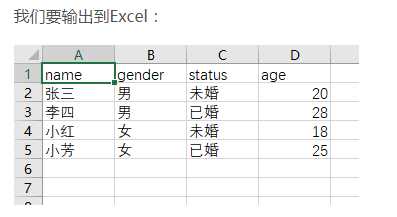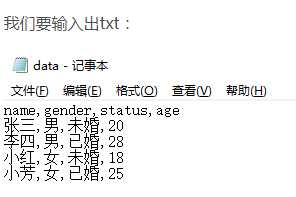标签:lis orm 技术 mat tools odi coding rom png


list1 = [[‘张三‘,‘男‘,‘未婚‘,20],[‘李四‘,‘男‘,‘已婚‘,28],[‘小红‘,‘女‘,‘未婚‘,18],[‘小芳‘,‘女‘,‘已婚‘,25]] output = open(‘data.xls‘,‘w‘,encoding=‘gbk‘) output.write(‘name\tgender\tstatus\tage\n‘) for i in range(len(list1)): for j in range(len(list1[i])): output.write(str(list1[i][j])) #write函数不能写int类型的参数,所以使用str()转化 output.write(‘\t‘) #相当于Tab一下,换一个单元格 output.write(‘\n‘) #写完一行立马换行 output.close()


list1 = [[‘张三‘,‘男‘,‘未婚‘,20],[‘李四‘,‘男‘,‘已婚‘,28],[‘小红‘,‘女‘,‘未婚‘,18],[‘小芳‘,‘女‘,‘已婚‘,25]] output = open(‘data.txt‘,‘w‘,encoding=‘gbk‘) output.write(‘name,gender,status,age\n‘) for row in list1: rowtxt = ‘{},{},{},{}‘.format(row[0],row[1],row[2],row[3]) output.write(rowtxt) output.write(‘\n‘) output.close()
组合
combinations:不考虑顺序的排列组合 import itertools print list(itertools.combinations([1,2,3,4],3)) [(1, 2, 3), (1, 2, 4), (1, 3, 4), (2, 3, 4)] permutations:考虑顺序的排列组合 import itertools print list(itertools.permutations([1,2,3,4],2)) #第二个参数2表示要选几个对象 [(1, 2), (1, 3), (1, 4), (2, 1), (2, 3), (2, 4), (3, 1), (3, 2), (3, 4), (4, 1), (4, 2), (4, 3)]
from itertools import product l = [1, 2, 3] print (list(product(l, l))) print (list(product(l, repeat=3))) 结果: [(1, 1), (1, 2), (1, 3), (2, 1), (2, 2), (2, 3), (3, 1), (3, 2), (3, 3)] [(1, 1, 1), (1, 1, 2), (1, 1, 3), (1, 2, 1), (1, 2, 2), (1, 2, 3), (1, 3, 1), (1, 3, 2), (1, 3, 3), (2, 1, 1), (2, 1, 2), (2, 1, 3), (2, 2, 1), (2, 2, 2), (2, 2, 3), (2, 3, 1), (2, 3, 2), (2, 3, 3), (3, 1, 1), (3, 1, 2), (3, 1, 3), (3, 2, 1), (3, 2, 2), (3, 2, 3), (3, 3, 1), (3, 3, 2), (3, 3, 3)]
标签:lis orm 技术 mat tools odi coding rom png
原文地址:https://www.cnblogs.com/xaiobong/p/10368039.html